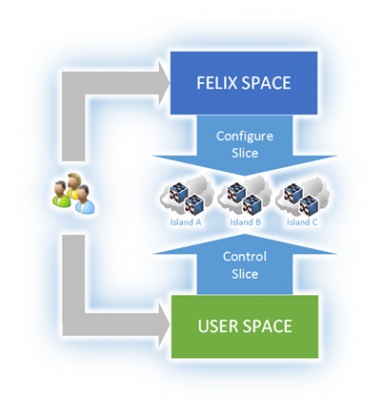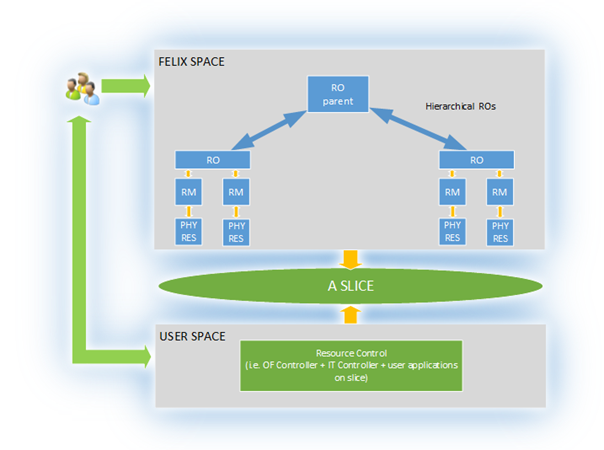FELIX aims to provide a framework for integration of resources of different kinds (e.g. transit network, SDN, IT, etc.) residing in a multi-domain heterogeneous environment. The FELIX architecture is the result of a careful analysis of the state of the art in relevant FI research projects in both Europe and Japan. From the European side, the OFELIA, FIBRE and Fed4FIRE projects were taken into account thereby providing a working approach to large-scale distributed systems and federation (e.g. through SFA and GENI), as well as addressing federation between heterogeneous testbeds. From the Japanese testbeds, GridARS and RISE were considered in order to manage seamlessly the establishment of dynamic inter-domain communication through the NSI protocol. Taken together, we have defined a modular and multi-layer architecture for the FELIX control framework
The resulting architecture is flexible and scalable to assure a sufficient level of interaction between various system components. In the FELIX project it is agreed to use a hierarchical model for inter-domain dependency management, with orchestrator entities responsible for synchronization of resources available in particular administrative domains.
The architecture can be seen as a combination of two spaces (see below figure):

- FELIX Space consists of management and control tools to coordinate processes of creation of a virtual environment in a heterogeneous, multi-domain and geographically distant test-bed. The components of the FELIX space will operate in hierarchical model, to enable efficient information management and sharing across multi-domain environment.
- User Space consists of any tool or application a user wants to deploy to control his virtual network environment or to execute a particular operation within it. The selection of tools is completely dependent on specific user requirements and is out of scope of the FELIX framework.
Both spaces play distinct roles in creation and operation of each virtual network environment, which is created by the FELIX Space upon a request from a user, and then managed by user tools in the USER Space. The figure below depicts more detailed architecture view, including the main functional blocks and their dependencies:

The FELIX Space relies on Resource Orchestrators (ROs), Resource Managers (RMs), and the physical (testbed) infrastructure to provide the resources needed for realizing a user slice. Resource Orchestrators (ROs) are stateful entities, responsible for the orchestration of the end-to-end, multi-domain service in the federated infrastructure. It coordinates the reservation and allocation of heterogeneous network and compute resources in each segment.
RM are components in charge of controlling a specific type of resource, being the equivalent of the SFA Aggregate Manager and NSA in NSI Framework. FELIX defines three basic types of RMs: the Transit Network RM (TN RM), the SDN RM, and Computing RM (C RM), responsible for management of Transit Network, SDN and Computing virtual resources respectively. In particular, the SDN RM will control the OpenFlow-based L2 resource in the access domains, while the TN RM will be focused on on-demand multi-domain provisioning of connectivity in the transit segment.
The User Space configuration depends mostly on FELIX end user preferences and choices. The user has a freedom to choice any Resource Controller, that is suitable for his/her needs. This controller is in charge of managing the creation, modification and deletion of slices related to the experiments (including all functionality, APIs and applications) basing on resources assigned by the FELIX Space components.
In parallel to both FELIX and User Spaces, there will be deployed a FELIX Monitoring Framework. It will collect and manage monitoring data from infrastructure slices and experiments, including information retrieved from the different SDN islands and from the transit domains, in terms of performance of the established connectivity services. The monitoring framework is expected to interact with the Resource Orchestrator for providing aggregated measurements.
More details on architecture and its components can be found in D2.2 “General Architecture and Functional Blocks” document and in whitepaper, “The FELIX architecture for large scale SDN and NSI experiments”.
Please also download the FELIX Whitepaper describing the FELIX architecture for large scale SDN and NSI experiments.